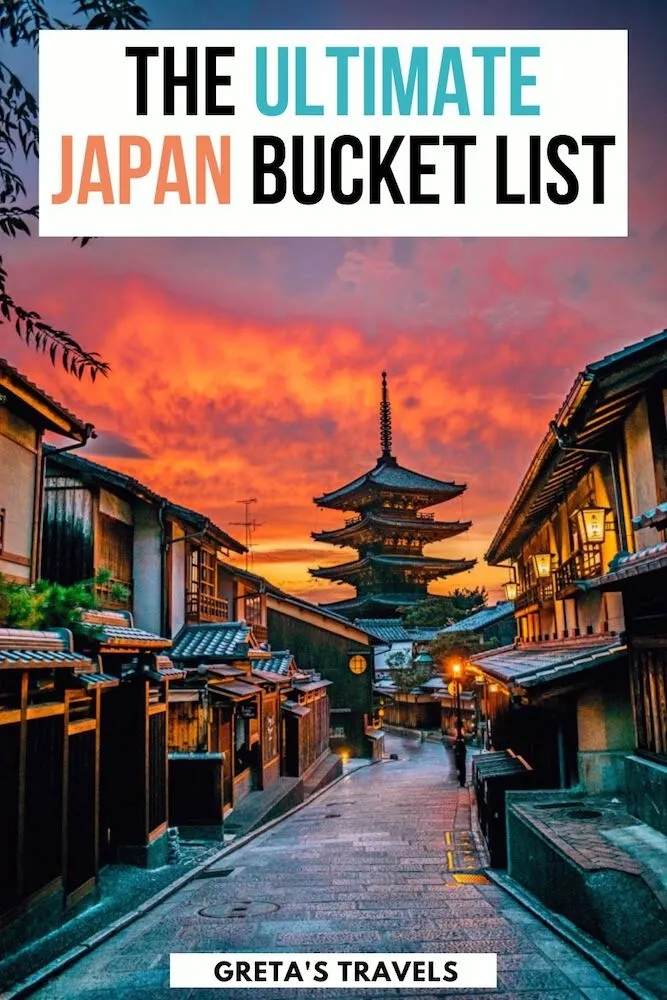As someone who grew up reading manga and doing Judo, Japan has always been a dream destination for me. Spending two weeks in Japan last year was a travel dream come true.
I had the opportunity to visit some of the most famous areas of Japan, but unfortunately I didn’t have time to venture much beyond the standard tourist route.
Which is why I teamed up with other travel bloggers to bring to you the ultimate Japan bucket list.
In this guide we’ve compiled all the most awesome things to do and most beautiful places in Japan. If you need help deciding where to go in Japan, this is the guide for you.
So let’s dive into our epic Japan bucket list!
Contents
- 1 Japan Bucket List – Kanto Region
- 2 Japan Bucket List – Kansai Region
- 2.1 Visit Fushimi-Inari Taisha in Kyoto
- 2.2 Explore the Gion neighbourhood in Kyoto
- 2.3 Explore the Arashiyama bamboo grove
- 2.4 Try the street food at Nishiki Market, Kyoto
- 2.5 See the wild deer in Nara
- 2.6 Visit Osaka Castle
- 2.7 Taste the street food in Dotonbori, Osaka
- 2.8 Admire the views from Himeji Castle
- 2.9 Visit Yoshino
- 2.10 Explore Mount Koya
- 3 Japan Bucket List – Hiroshima Region
- 4 Japan Bucket List – Chubu Region
- 5 Japan Bucket List – Kyushu & Okinawa Region
- 6 Japan Bucket List – Hokkaido Region
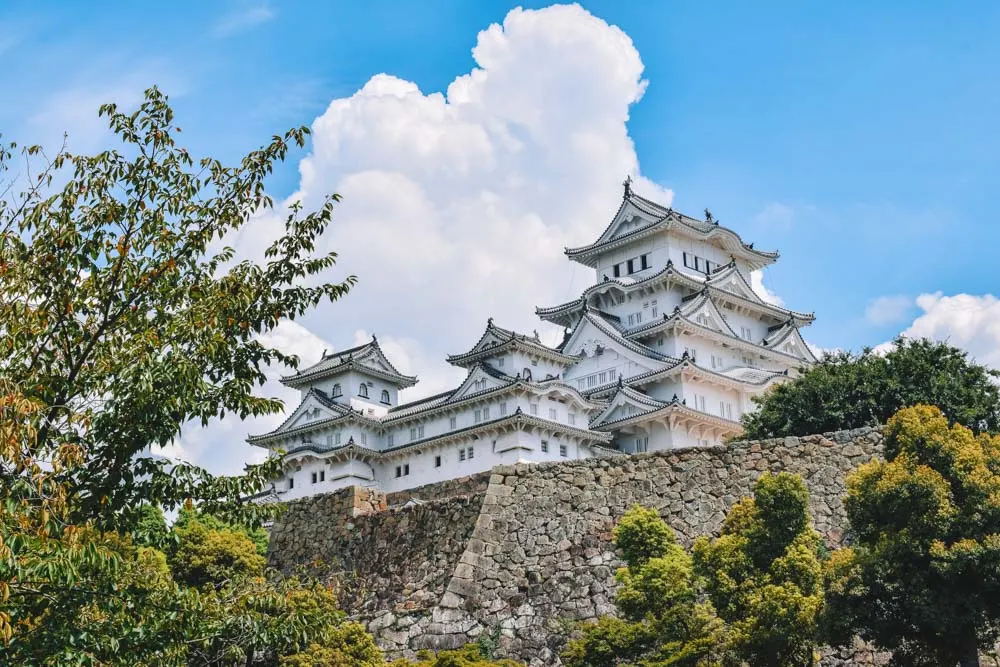
The outside of Himeji Castle
Japan Bucket List – Kanto Region
Visit the Big Buddha of Kamakura
Kotoku-in is a Buddhist temple in the city of Kamakura, a short train journey away from Tokyo. It’s home to the Big Buddha of Kamakura; a huge bronze 13 metres tall statue.
It’s one of the most famous attractions in Japan. The statue is hollow and for a small extra fee you can go inside the Big Buddha. It’s surrounded by peaceful gardens that you can walk around.
However it’s not the only thing that Kamakura has to offer. After you visit Kotoku-in make sure to pay a visit also Tsurugaoka Hachiman-gu Temple and Komachi Street.
It’s a beautiful Shinto temple, and seeing the two together makes for a good history day trip from Tokyo.
| READ MORE: KAMAKURA DAY TRIP FROM TOKYO |
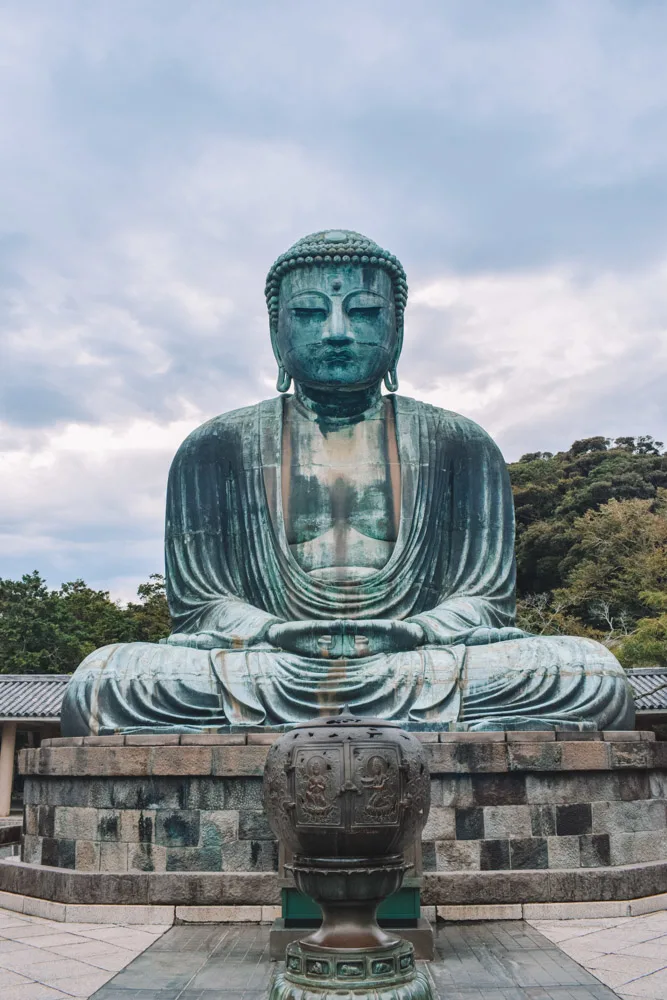
The famous big buddha of Kamakura in Japan
Cross the street at the famous Shibuya Crossing
The chaotic streets of Tokyo are probably one of the first things that come to mind for many people when they first think of Japan. And nothing represents that more than the famous Shibuya Crossing.
With its diagonal crossing and key location, Shibuya Crossing has been named the busiest crossing in the world, and it’s easy to see why! Crossing the street here will make you will feel part of the hustle and bustle of Tokyo.
Don’t limit your Shibuya visit to just that though. Head over to the Starbucks in Shibuya Crossing, it has a top floor where you can sit and see the crossing from above.
By Shibuya you will also find the statue to Hachiko. The neighbourhood is also really cool with loads of shops, bars and restaurants for you to explore.

Shibuya crossing seen from the top floor of Starbucks in Tokyo
Learn about manga & kawaii culture in Akihabara & Harajuku
I’ve already mentioned I used to read a lot of manga. As soon as I got to Tokyo I knew I had to explore Akihabara and Harajuku, the manga neighbourhoods of Tokyo.
Even if you’re not a manga fan, they’re really interesting areas to visit as they give you an insight into the manga and kawaii culture in Japan. In Harajuku especially you will find loads of stores selling typically kawaii products.
Whether it’s cute and colourful food, clothing or gadgets, you’re to find something! Akihabara is more focused on manga, with comics, videogames and figurine stores all over the neighbourhood.
| READ MORE: HOW TO SPEND 5 AWESOME DAYS IN TOKYO |

Exploring Akihabara in Tokyo
Explore the nightlife in Golden Gai & Omoide Yokocho
Golden Gai and Omoide Yokocho are two streets in Shinjuku, Tokyo. Although they’re very different streets, they have a similar hushed and nostalgic feel, hidden away amongst the skyscrapers of Tokyo.
Omoide Yokocho, also known as Nostalgia Alley or Piss Alley, is a small street lined with tiny one-room restaurants and colourful lamps. It’s distinctly different from the surrounding chaotic streets of Shinjuku.
Golden Gai is more a group of streets than an individual one. There are a few parallel streets lined with tiny bars. I loved wandering around Golden Gai and having drinks in every bar, soaking in the atmosphere.
I recommend visiting in evenings since the streets will be more picturesque with the lights on. It’s also the perfect opportunity to taste some sake and experience the Tokyo nightlife!
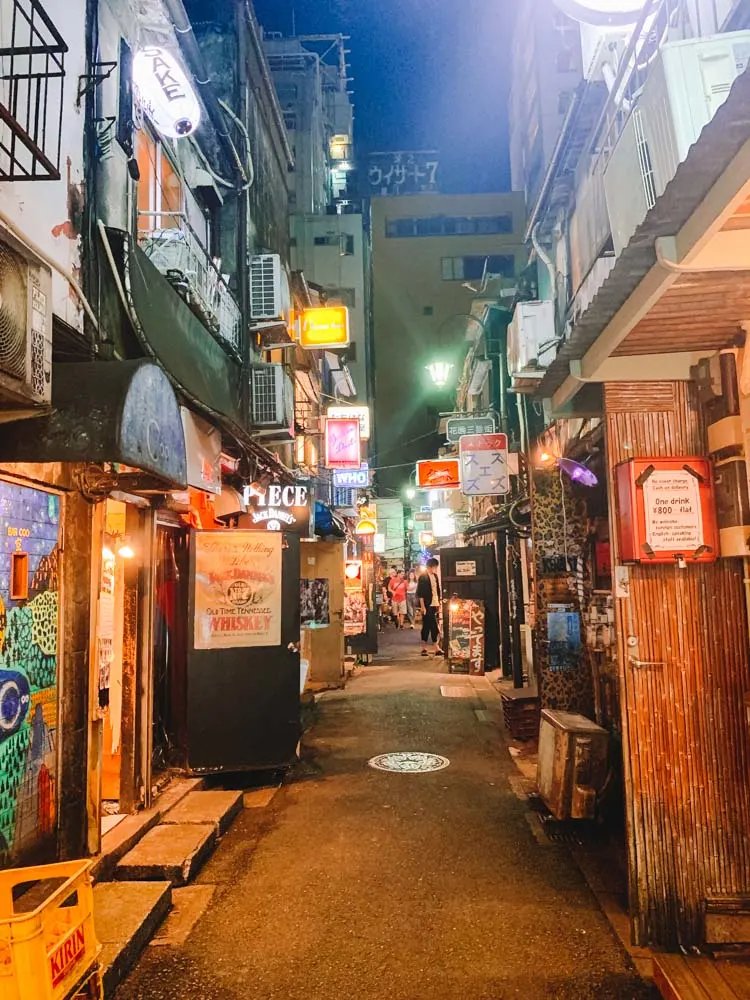
The streets and bars of Golden Gai in Shinjuku at night
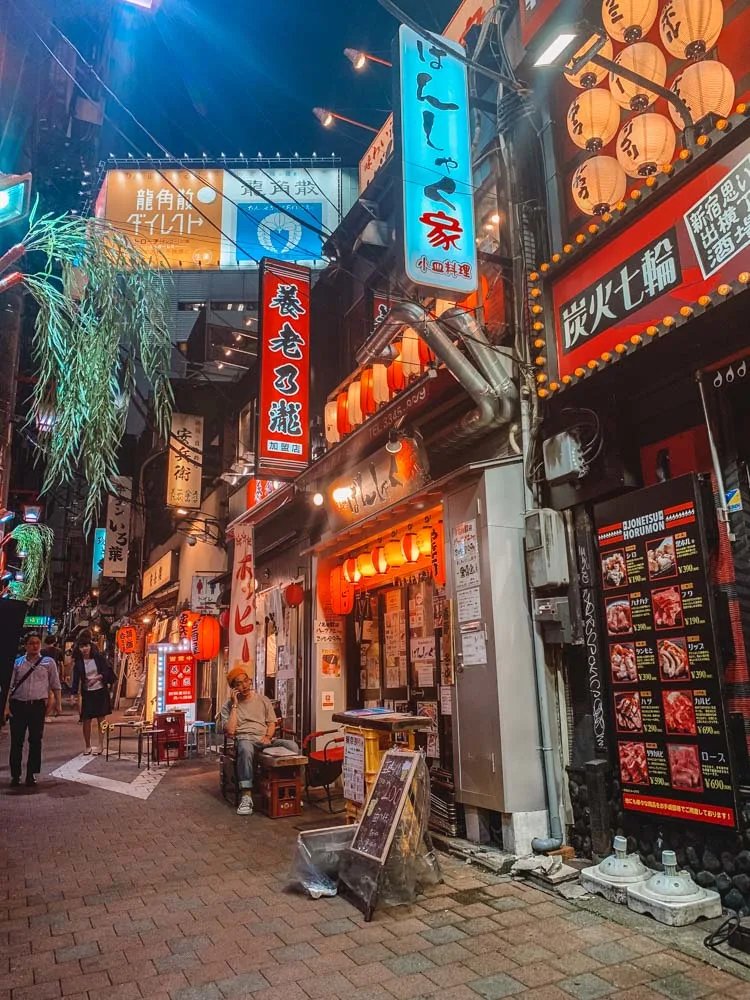
Omoide Yokocho, known as “piss alley”, at night in Shinjuku
Explore the temples of Asakusa
There is no lack of beautiful temples and palaces in Japan, however Asakusa in Tokyo is worthy of a special mention.
The whole neighbourhood has an older Tokyo vibe, with smaller buildings, traditional crafts shops and street food stalls.
Asakusa is also home to the beautiful Senso-iji temple. Senso-iji is an ancient Buddhist temple, as well the oldest temple in Tokyo.
With its distinctive red colour and five-story pagoda, it’s one of the most recognisable and Instagrammable spots in Tokyo.
No Japan bucket list would be complete without a visit to Asakusa!
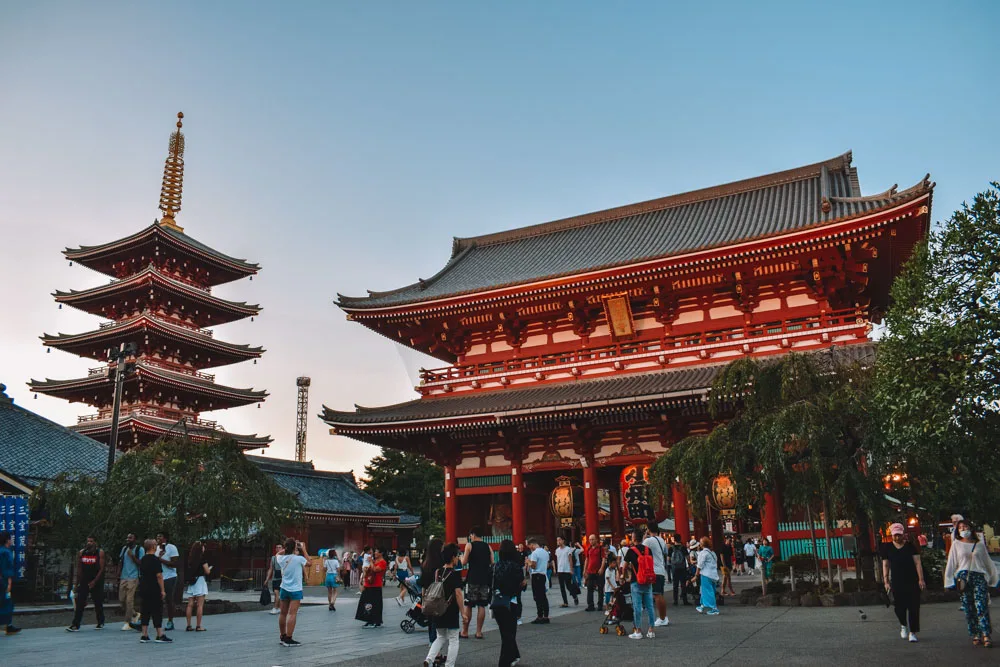
Senso-ji temple in Asakusa, Tokyo
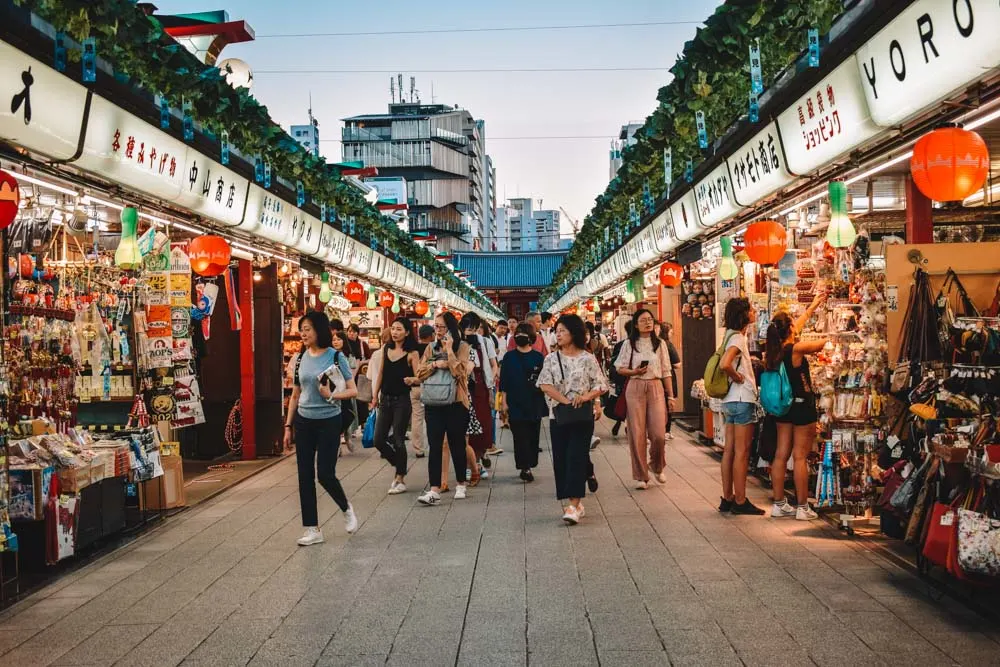
The road of cute shops leading up to Senso-ji temple in Asakusa, Tokyo
Visit Hakone
“With Mount Fuji views, natural hot springs and a picturesque torii gate, a visit to Hakone is a worthy bucket list experience.
Located approximately 90 minutes from Tokyo, a great way to experience the area is with a Hakone Free Pass.
Departing Hakone’s main train station, Hakone-Yumuto, you can do a circular route of the area jumping between many different modes of transport.
You’ll ride along the Hakone Ropeway, a cable car that glides above volcanic sulphur fields below. Jump onto a pirate ship for a cruise of Lake Ashi.
If it’s a clear day, Mount Fuji is clearly visible from the lake. Walk around to the Hakone Shrine where a red torii gate sits in the water.
If you’ve got extra time, consider staying 2 days in Hakone so you can relax at an onsen one evening.”
– by Kristen Miller, author of Our Passion for Travel
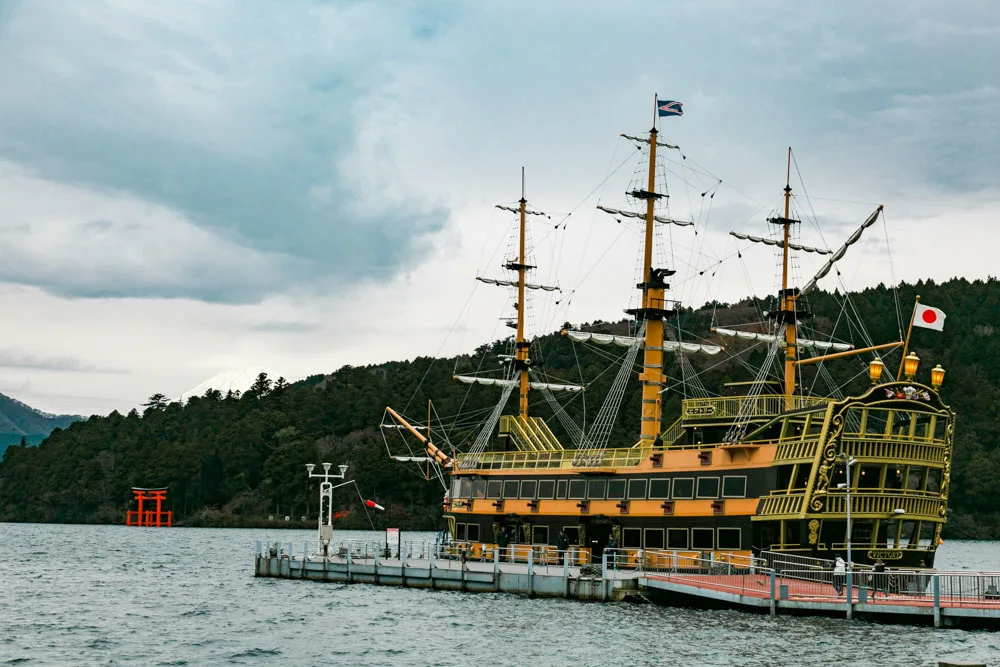
Hakone – photo by Our Passion for Travel
Japan Bucket List – Kansai Region
Visit Fushimi-Inari Taisha in Kyoto
The red torii gates of Fushimi-Inari Taisha are probably one of the most iconic and recognisable landmarks in Japan.
Fushimi-Inari Taisha is an important Shinto shrine, famous for the 5,000 orange torii gates that wind through the hills and shrine.
If you follow the full path through the gates, up the mountain and back it will take around 2-3 hours. From the peak you will get some pretty awesome views over Kyoto.
Being a popular attraction, it obviously gets pretty busy. However don’t let the crowds put you off. The further along the path you go the less people you will find. It’s a must-see and unlike any other temple I’d previously seen.
| READ MORE: 3 EPIC DAYS IN KYOTO |
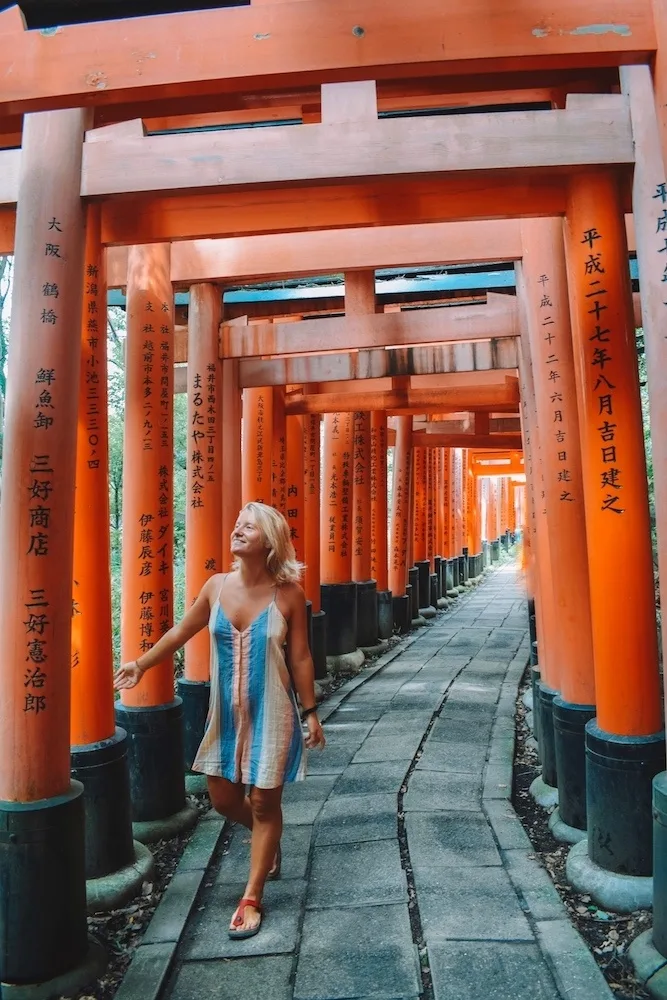
Exploring Fushimi Inari-Taisha in Kyoto, Japan
Explore the Gion neighbourhood in Kyoto
Wandering around the streets of the Gion neighbourhood was amongst my favourite things to do in Kyoto. Gion is Kyoto’s geisha district, and it’s not uncommon to see people in colourful kimonos in the area.
The neighbourhood is lined with low traditional Japanese houses, which give the neighbourhood an ethereal quality, as if you’ve just stepped back in time.
You will find plenty of restaurants, boutiques and teashops where you can eat, relax and shop.
The most notable spot in Gion is, in my opinion, the street leading up to the Hokan-ji Temple pagoda. This 5-story Buddhist pagoda towers over the surrounding low houses, creating a sharp contrast especially at sunset.
No Japan bucket list would be complete without a wander through the streets of Gion and watching the sun set behind the Hokan-ji pagoda.

The pagoda of Hokanji temple at sunset
Explore the Arashiyama bamboo grove
The Arashiyama bamboo grove is considered one of the most popular attractions in Kyoto, if not Japan. Here you will find a path that leads you around the grove, flanked by bamboo as tall as 30 metres on every side.
Walking down the path and just seeing green on every side and high above you is quite an eerie experience. It gets very crowded so make sure to head there early in the morning to enjoy the quiet of the bamboo grove.
Near Arashiyama you will find also Tenryuji Temple, a UNESCO World Heritage Site, and the Okochi-Sanso Villa, an imperial villa and museum.
You can pair your visit to the bamboo grove to the temples if you want a combination of nature and history.
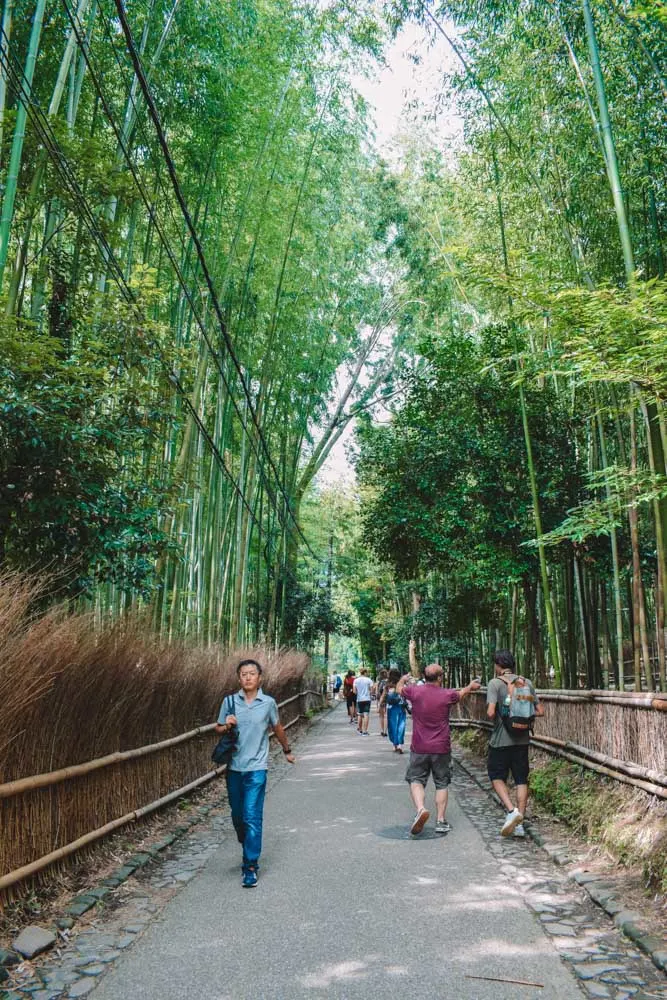
Arashiyama bamboo grove in Kyoto
Try the street food at Nishiki Market, Kyoto
One thing I wasn’t expecting about Japan before travelling there was the vast amount of street food. Pretty much everywhere we went there would be stalls or shops from which you could grab food on the go.
One of my favourite places was without a doubt Nishiki Market in Kyoto. This huge covered market offers plenty of street food, as well as some clothing stalls and shops.
I spent a whole afternoon just wandering around the market trying different things. My favourite quirky foods I tried were kobe beef sushi, dango skewers and Hello Kitty shaped ice cream.
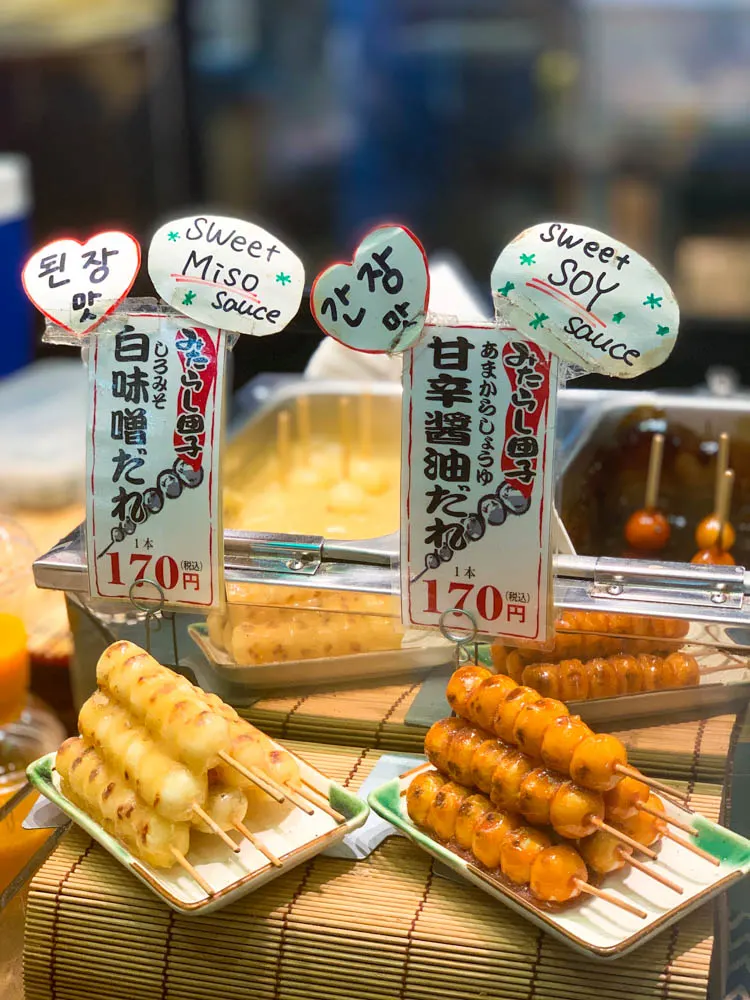
Dango skewers at Nishiki market in Kyoto – they soon became my favourite dessert in Japan!
See the wild deer in Nara
The lovely city of Nara is especially famous for Nara Park, where tame deer roam free. The deer in Nara are free and wild, however they’ve been around people for so long they’re fairly tame.
However that doesn’t mean you’re allowed to pester them! They’re still wild animals and should be treated as such, don’t try to pet them and definitely don’t feed them inappropriate food.
You will find most of the deer gathered around Nara Park. Nara Park is also home to some of the most famous temples in Nara; Todaiji Temple, Kasuga-Taisha Temple and the Kofukuji five-stories pagoda.
You can make the most of your Nara trip by walking from one temple to the next and, walking through the park as you do so. That way you can combine seeing the wild deer with visiting some of Japan’s most famous temples!
| READ MORE: NARA 1-DAY ITINERARY |
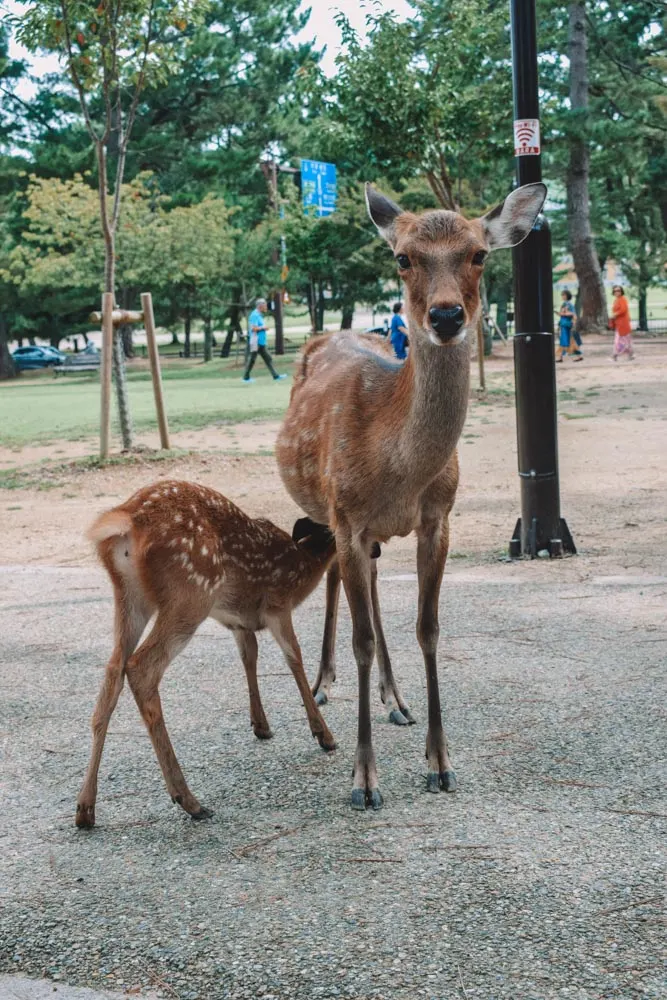
A female deer and her fawn in Nara Park
Visit Osaka Castle
Osaka Castle sits in the middle of a park in central Osaka. It was built in 1583 and has huge historical importance, having played a major rule in the unification of Japan.
With its eight floors it sits tall above the surrounding gardens and rooftops of Osaka. Inside the museum you will find a museum dedicated to the history of Osaka and Japan, with also a restaurant and souvenir shops.
But the highlight of the castle, in my opinion, is the incredible view over Osaka that you get from the top floor of the castle.
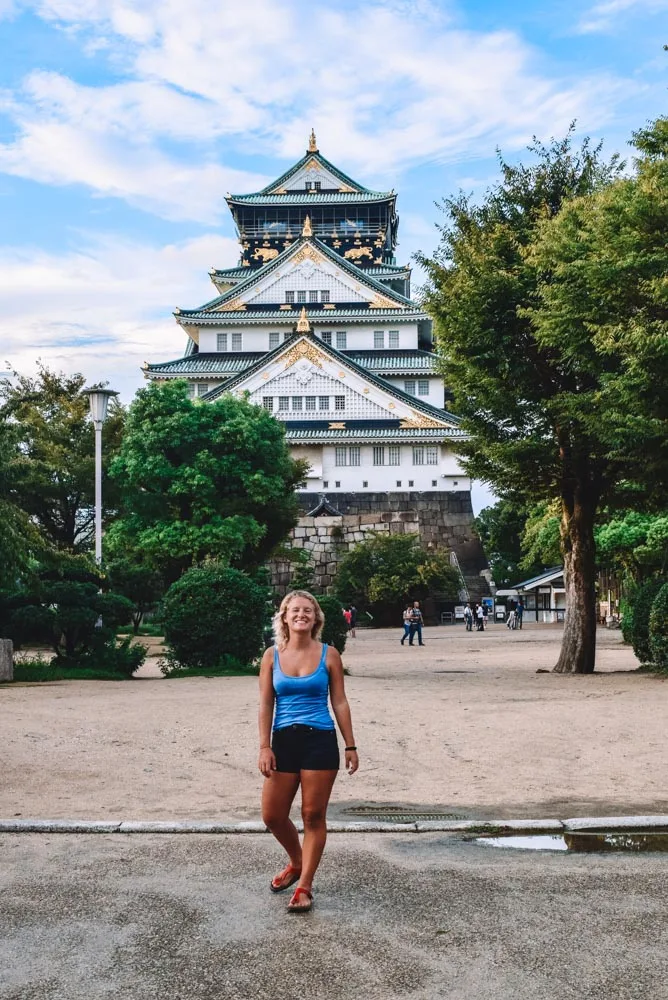
Exploring Osaka castle
Taste the street food in Dotonbori, Osaka
Dotonbori is famous for being one of the main attractions in Osaka. The streets that run along the Dotonbori canal are packed with street food stalls, funky shops, bright lights and whacky shop fronts.
I recommend visiting in the evening when all the shop signs are lit up to really soak in the crazy atmosphere. Here you will find a huge variety of both street food stalls and cosy restaurants.
I had the best takoyaki of my Japan trip at a random stall in Dotonbori. Dotonbori is famous for its foodie experiences so definitely give one of the whacky stalls a try! Even if you don’t taste anything Dotonobori is still worthy of a visit.
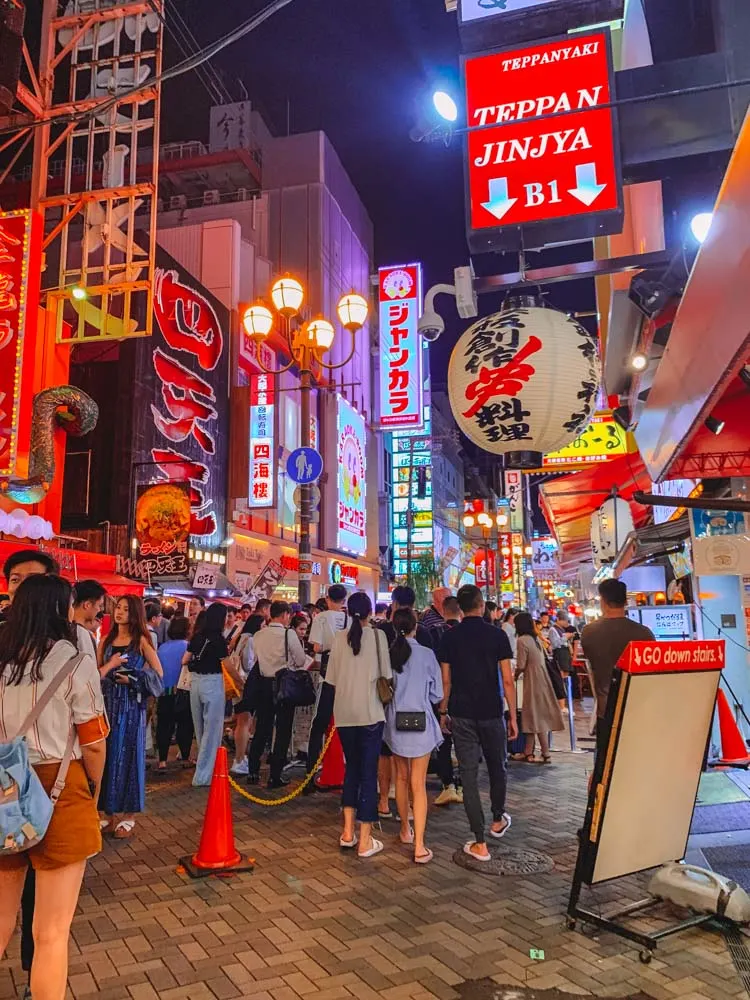
Exploring the street food in the Dotonbori neighbourhood of Osaka
Admire the views from Himeji Castle
Himeji Castle was possibly my favourite castle in Japan. The architecture of the castle is simply stunning, with elaborate carvings and an elaborate exterior.
The inside of the castle is fairly plain, with most of the rooms stripped of their furnishings to allow space for visitors. However what stood out most to me were the epic views from the top floors of Himeji Castle.
Perched slightly higher than the surrounding houses, the top floors of Himeji Castle have 360 views over Himeji and the surrounding countryside. It’s a must on any Japan bucket list.
| READ MORE: AN EPIC DAY TRIP TO HIMEJI CASTLE |
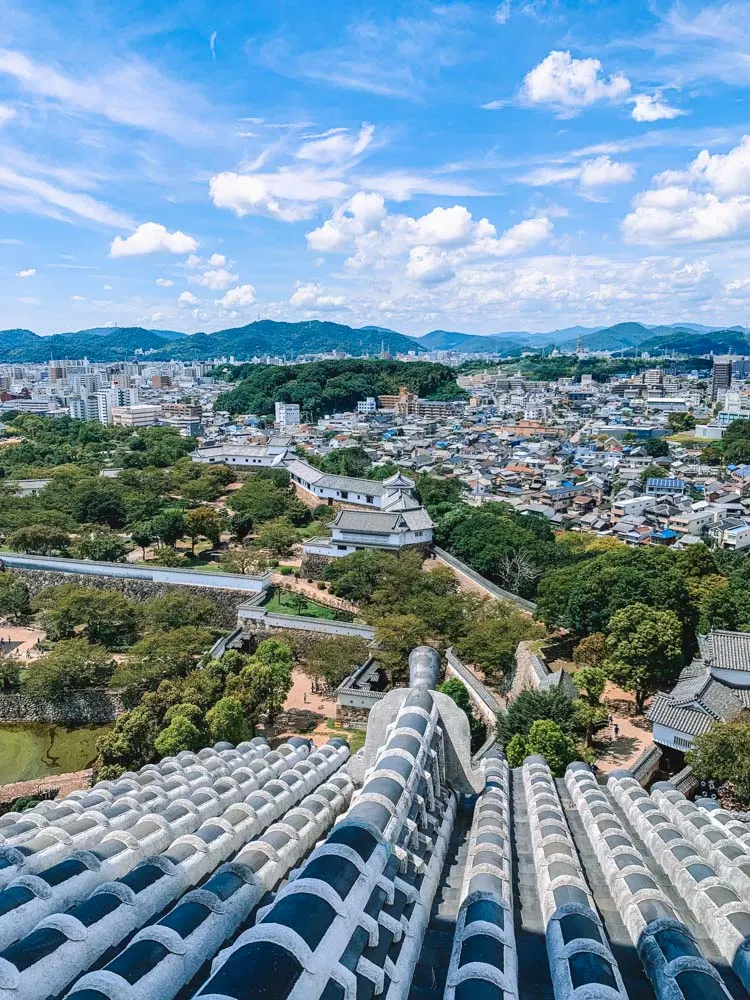
The view from the top of Himeji Castle
Visit Yoshino
“When international tourists visit Nara, they mostly stick to the city itself and the infamous deer park – an easy day trip from Kyoto or Osaka. However, there’s so much more to see in the Prefecture of Nara, far away from the tourist crowds.
One of my highlights is the small town of Yoshino, located in the Kii mountains (but still easy enough to reach by train).
Yoshino is an UNESCO World Heritage Site, with lots of important temples and shrines in the small town. Additionally, the area is also great for hiking.
Once you make it up the hill to the Hanayagura Observatory, you’ll have an incredible view of the surrounding landscape – which is particularly stunning during autumn for the fall leaves, or during spring for the cherry blossoms.
In case you’re staying overnight, Yoshino is also a great place to stay in a traditional Japanese guesthouse (called Ryokan) – an experience you can’t miss on your Japan bucket list!”
– by Patrick, author of German Backpacker
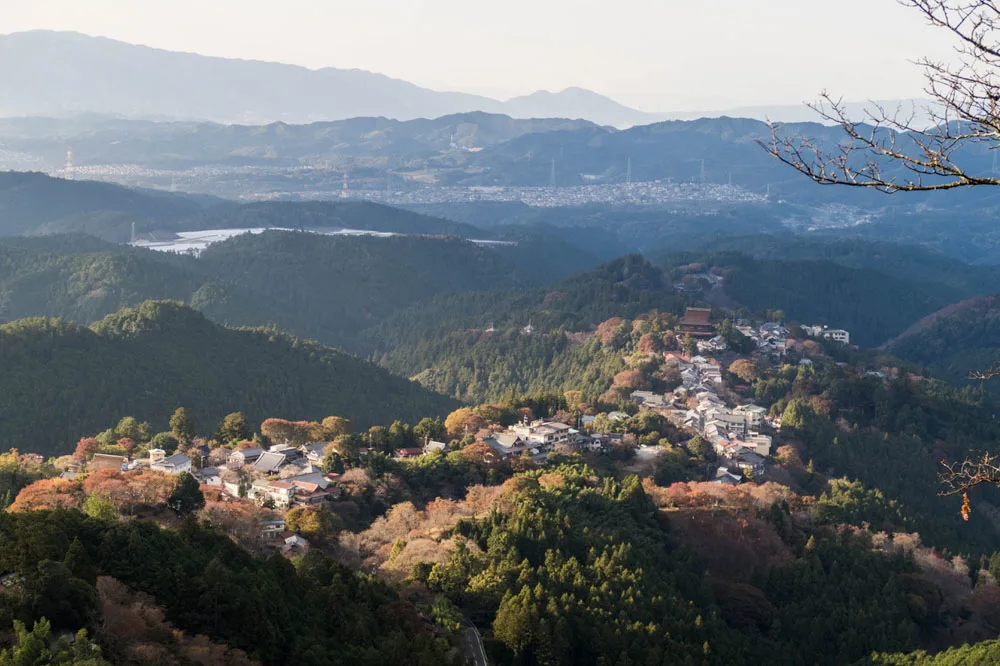
View over Yoshino – photo by German Backpacker
Explore Mount Koya
“At first glance, the journey to reach Mount Koya (respectfully known as Koyasan in Japan) seems a little long-winded.
But the trip via train, cable car and finally bus, is a beautiful one and absolutely recommended to the spiritual centre of Shingon Buddhism in Japan.
This form of Buddhism was brought to Japan in 805 by Kobo Dashi, and in the centuries since, several historic temples have been built.
Many offer a unique spiritual overnight stay to visitors, and you don’t need to be a practicing Buddhist to do so.
During your stay you can observe the monks’ prayers, take part in meditation lessons and enjoy a traditional Buddhist vegetarian meal.
Visiting Okuno-in is a major attraction of Koyasan, being the site of Kobi Dashi’s mausoleum.
This incredible graveyard in the woods is the largest cemetary in Japan, and walking through the forest between the 200,000 plus tombstones is a very calming experience.
At dusk, lanterns lit along pathways provide a spectacular sight.”
– by Kavita Favelle, author of Kavey Eats
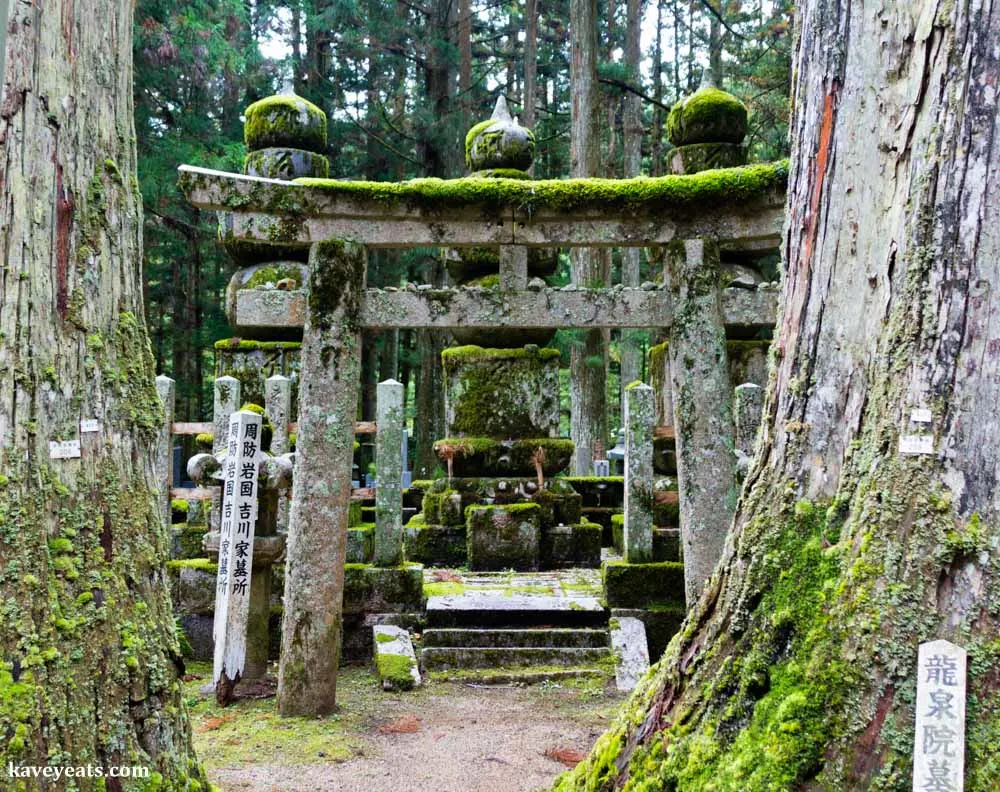
Okuno-in – photo by Kavey Eats
Japan Bucket List – Hiroshima Region
Visit the Hiroshima Peace Memorial & Museum
I didn’t expect the Hiroshima Peace Memorial to affect me as much as it did. The museum is a collection of objects and stories of the victims of the Hiroshima atomic bomb, as well as the survivors.
It stands as a reminder of the horrors of nuclear war, begging humanity to do better and asking for “No more Hiroshimas”.
It’s a tough place to see, I was shocked to see a classroom of children around seven years old there on school trip when I was visiting, but it’s a must nonetheless.
It’s a big part of both Japan and the world’s history. You can’t visit Hiroshima and not pay a visit to the memorial.
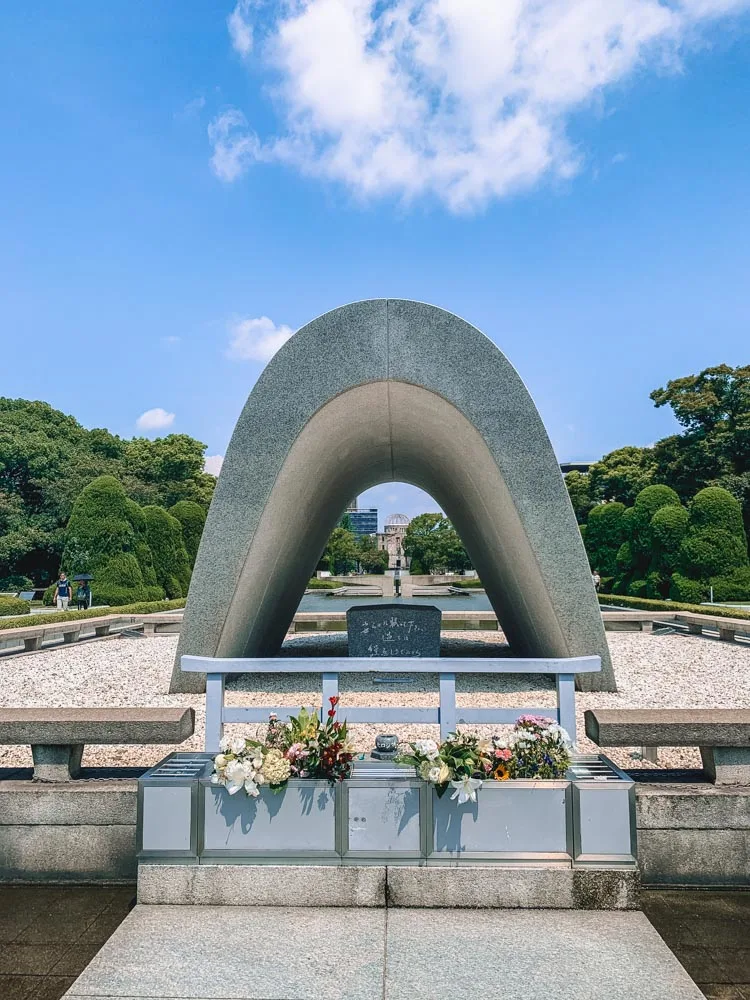
Hiroshima Peace Memorial
Explore Miyajima Island
Itsukushima, also known as Miyajima Island, is a small island in Hiroshima Bay. It’s famous for the giant floating orange torii gate that stands in the sea just off shore from the island, marking the entrance to the Itsukushima Shrine.
The island is simply beautiful. We arrived in Miyajima after the hustle and bustle of Tokyo and Kyoto, and felt instantly relaxed at the slow pace and chill vibes of the island.
The island is entirely pedestrian and is characterised by the traditional low houses. Walking the streets of Miyajima feels like walking through ancient Japan. Miyajima is also famous for its oyster farms, so make sure to taste these!
The main street has a lively and colourful street market, where you can taste the oysters fresh, fried or even stuffed with cheese. If you spend a night in Miyajima just remember that all the restaurants close early!
| READ MORE: THE BEST THINGS TO DO IN MIYAJIMA ISLAND |
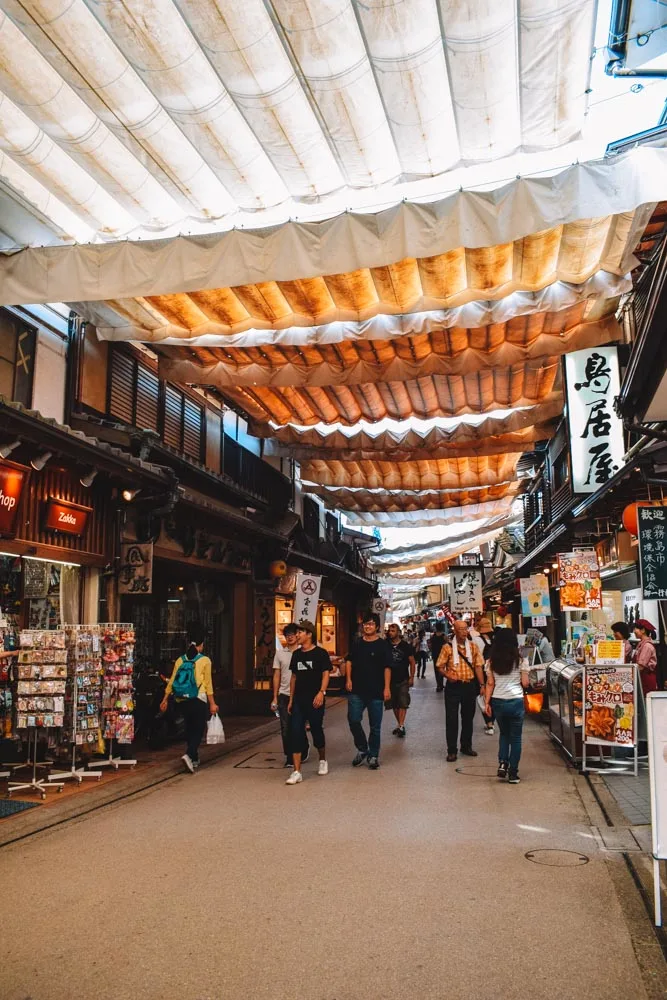
The cute market streets on Miyajima Island
Hike up Mount Misen
My favourite thing to do in Miyajima was the hike up Mount Misen. The mountain is sacred and you will find shrines and small temples dotted along the way up.
There are different trails up, which take around 1.5-2 hours to reach the peak. You can also take the cable car to the peak, and then hike back down.
From the top of Mount Misen you will get some incredible 360 views over Miyajima, the sea, Hiroshima and the coastline of mainland Japan, and the surrounding islands.

The view from the peak of Mount Misen in Miyajima Island
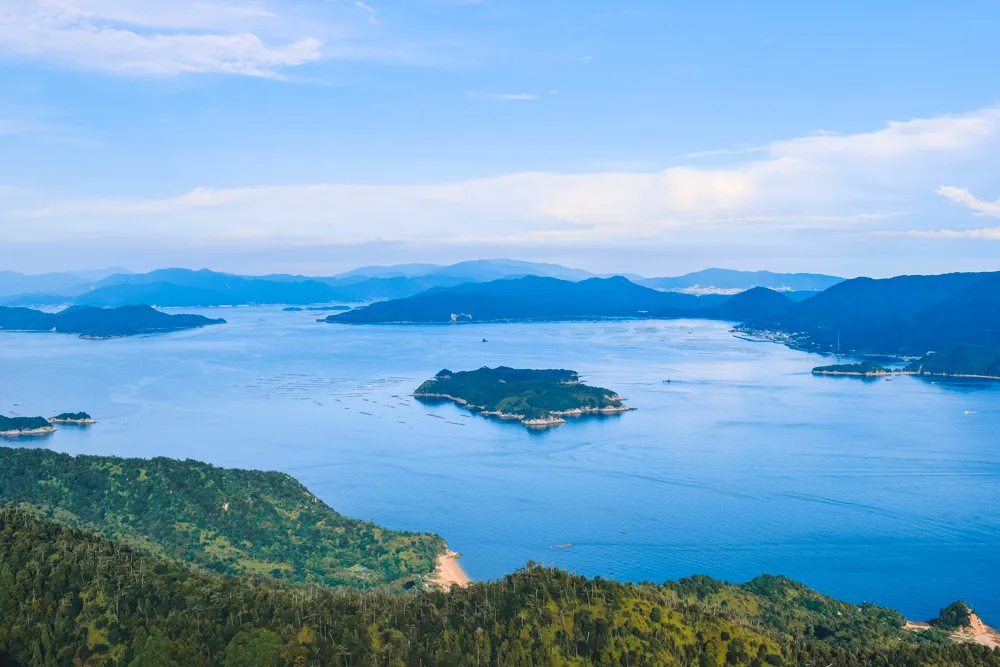
The view from the top of Mount Misen on Miyajima
Take the Hello Kitty Shinkansen train
Admittedly you can do this in other parts of Japan too, but I took the Hello Kitty train in Hiroshima so figured I’d add it to this section of the bucket list. Travelling with the high speed Shinkansen trains is a must-have experience in Japan.
Pair that with a branded Hello Kitty train and it becomes even more iconic. Most of the wagons only have discreet Hello Kitty additions like to the blinders that cover the windows.
However there are a couple of very heavily decorated Hello Kitty wagons where everything is pink and features the cute cat.
You can pair the very Japanese experience of travelling by high speed train with being surrounded by one of Japan’s kawaii icons, it doesn’t get more Japanese than that!
| READ MORE: IS THE JAPAN RAIL PASS WORTH IT? |
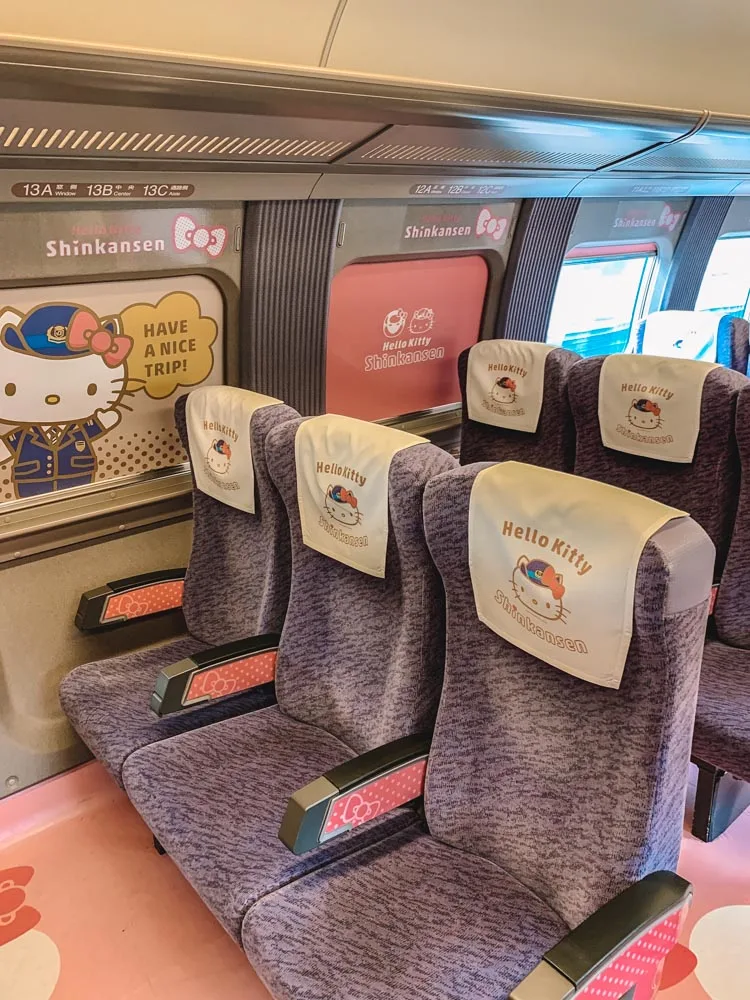
The seats on the Hello Kitty Shinkansen train from Hiroshima to Osaka
Cycle along the Shimanami Kaido
“If you want to go off the beaten path and explore another side of Japan, then you must cycle on Japan’s best bikeway, Shimanami Kaido.
The 70km dedicated cycle route starts in Onomichi on the main island of Honshu and ends in Imabari City on Shikoku Island.
The bikeway connects six islands across the Seto Inland Sea, where you can see rural Japan, colourful temples of Kosanji Temple and Miraishin no Oka, an Instagram-worthy spot.
It takes about eight to ten hours to complete the bike journey from Onomichi to Imabari. You can rent a city bike for ¥1,100 a day in Onomichi, cycle to Imabari, stay overnight and return to Onomichi the following day.
Or you can do a day trip cycling half the bike route or do a combination of bicycle and ferry on the same day.”
– by Queenie, author of Ms Travel Solo
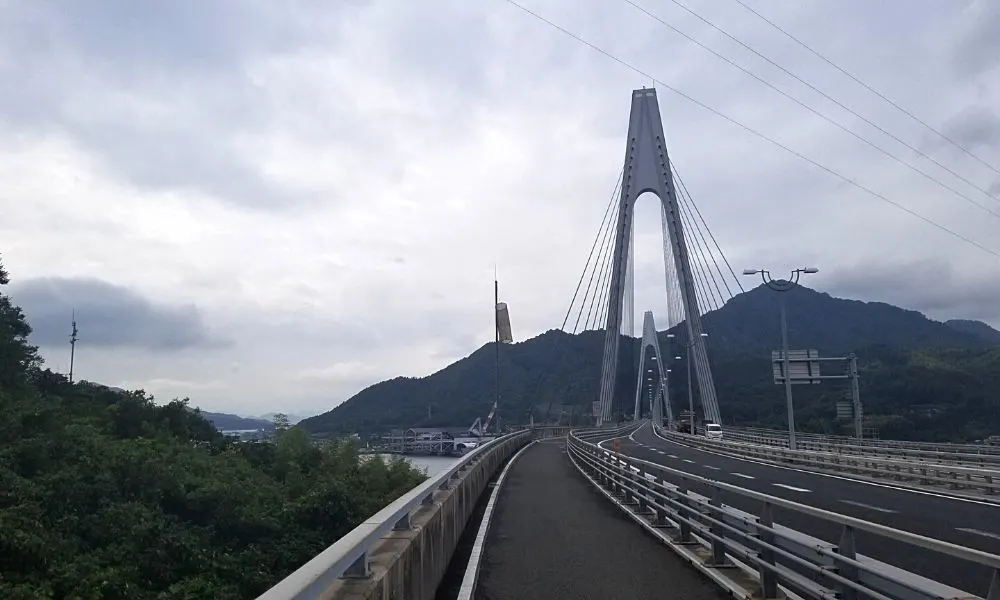
Cycling along the Shimanami Kaido – photo by Ms Travel Solo
Japan Bucket List – Chubu Region
Hike Mount Fuji at sunrise
“Watching the sunrise from the summit of the mighty Mount Fuji should definitely rate high on your Japan bucket list.
The official climbing season runs from July until mid-September, and is best accessed via a direct bus from Tokyo that stops right outside Mount Fuji 5th Station, the starting point for most climbers.
To summit in time for the sunrise without rushing, start your climb in the early afternoon, then rest at a mountain hut for some dinner and a few hours of rest before completing your hike through the night.
When it comes to the climb itself, there is a famous Japanese saying that springs to mind which states, “A wise man climbs Mount Fuji once, only a fool climbs it twice.”
It is important to remember that Fuji is a serious hike and you must prepare accordingly. That means taking enough supplies such as food and plenty of water and wearing hiking boots and clothing appropriate for climbing.”
– by Tanja, author of Ryokou Girl
https://www.instagram.com/p/B1ORtxCne08/
Explore the Yamanashi Prefecture
“Yamanashi Prefecture is a popular destination during cherry blossom season, but there are lots of other amazing things do in this picturesque prefecture southwest of Tokyo.
Yamanashi Prefecture is the home of breathtaking lakes, ancient shrines, unique museums and wonderful walks and hikes are possible, including of course, Mt. Fuji!
A quarter of Yamanashi prefecture is a national park and is a great destination for scenic walks and ancient shrines.
The Fuji Five lakes are the main attraction but the foothills of Mt Fuji and Shosenkyo Gorge are also spectacular, especially in Fall.
Lake Kawaguchiko has a long shoreline and is the most popular of the Fuji Five lakes because of its proximity to Tokyo.
Windsurfing, fishing, hiking or boating on the lake makes a great day trip from Tokyo and gives travelers a chance to see the stunning Japanese countryside.”
– by Monique, author of TripAnthropologist
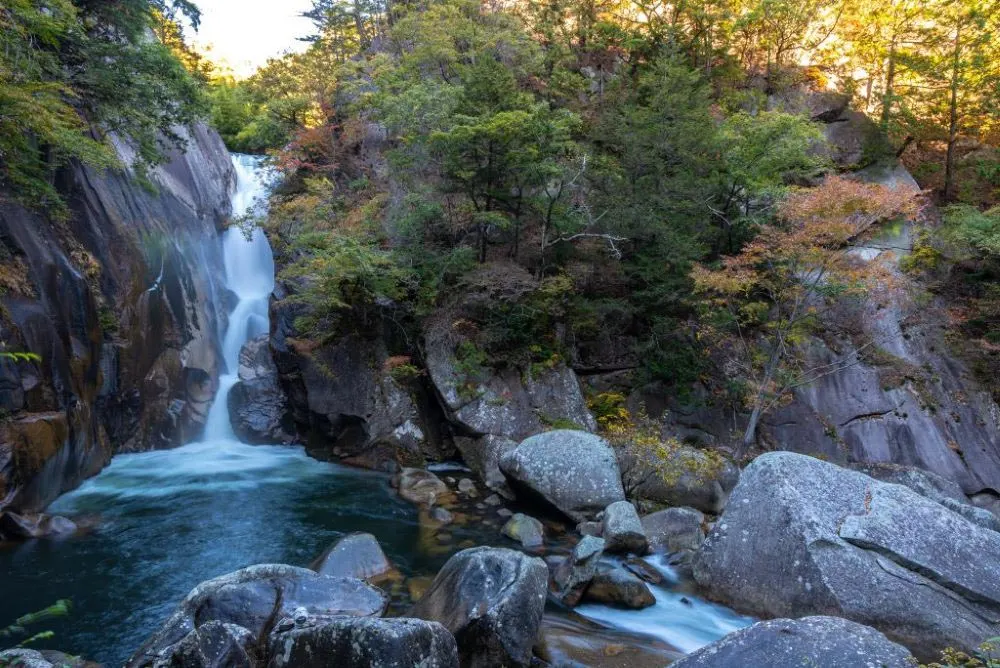
Exploring Senga Waterfall in the Yamanashi Prefecture – photo by TripAnthropologist
Explore Shirakawa
“Shirakawa, a mountain village located in the district of Ōno close to Kanazawa in Gifu Prefecture, is one of the places that should be on your Japan bucket list.
It is known for the historic villages of Shirakawa-gō and Gokayama, both world UNESCO heritage sites. Located in a remote valley, they are surrounded by the beautiful forested mountains of Ryōhaku.
There are three villages – Ogimachi, Ainokura and Suganuma at the foot of the mountains. You will find green fields around these traditional houses, amidst which the river flows.
These villages are known for their unique traditional homes built in Gasshō-style having thatched roofs, resembling two hands joined in prayer to sustain snowfall during the harsh winters.
You can plan a trip from Takayama to Shirakawa, as it is just 50 minutes away. Regular buses leave Kanazawa and Takayama to Shirakawa. There is no entry fee to walk around the villages.”
– by Reshma Narasing, author of The Solo Globetrotter
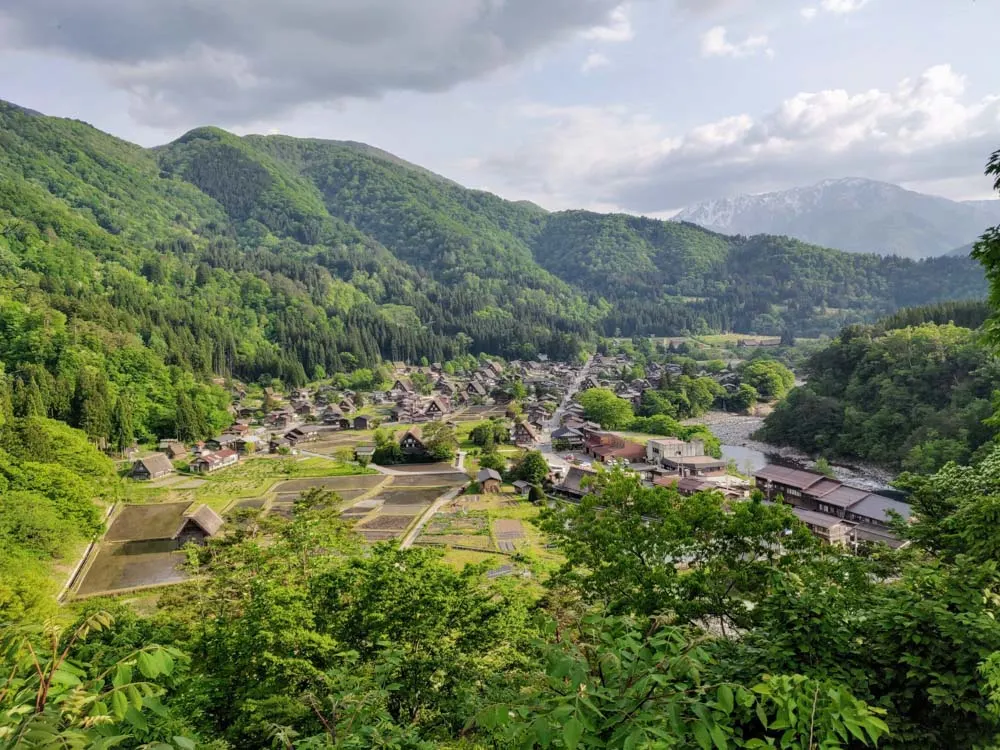
Shirakawa – photo by The Solo Globetrotter
Visit Lake Kawaguchiko & Oshino Hakkai
“Have you ever thought of doing a Tokyo to Mt Fuji day trip? With so many viewpoints to see Japan’s iconic volcano, the Fuji Five Lakes area is your best bet!
Located just 2 hours on highway bus from Tokyo, it’s possible to do a brief tea ceremony overlooking stunning Lake Kawaguchiko.
Afterwards, step outside to the lake’s shore to capture pictures of Mt Fuji reflecting into the water if the weather is on your side.
Nearby Oshino Hakkai is often overlooked by foreign tourists. This traditional themed village with thatched-roof restaurants and shops was created around 8 ponds that were formed by seismic activity from Mt Fuji.
These ponds are listed as a UNESCO World Heritage site due to the role they have played in Japanese folklore and for their sacred properties. With water so amazingly clear, in some places you can see 8 metres down!”
– by Alyse, author of The Invisible Tourist

View of Mount Fuji Lake Kawaguchiko – photo by The Invisible Tourist
Explore Kanazawa
“Kanazawa is the one place we could not leave off any Japan bucket list.
A small town on the west coast of Japan’s central Honshu Island, just 2 hours from Kyoto, the city claims many ancient attractions such as a well-preserved Edo-era district and glorious castle.
Its crown jewel, however, is the Kenrokuen traditional gardens, which is one of the “Three Great Gardens of Japan.”
Kenrokuen is 25 acres of pure pleasure. It features ponds, fountains, a range of plant and flower species, and the six desirable aspects of a perfect garden: spaciousness, solitude, artificiality, antiquity, abundant water, and broad views.
The longest fountain in Japan, a historic teahouse, and the Kotoji-tōrō, an emblematic stone lantern with two-leg, are just some of the highlights.
Kenrokuen is also famed for being breathtaking in any season – meaning no matter when you visit Japan, Kanazawa (and Kenrokuen) should unquestionably be on your bucket list.”
– by Jordan, author of Inspired Maps
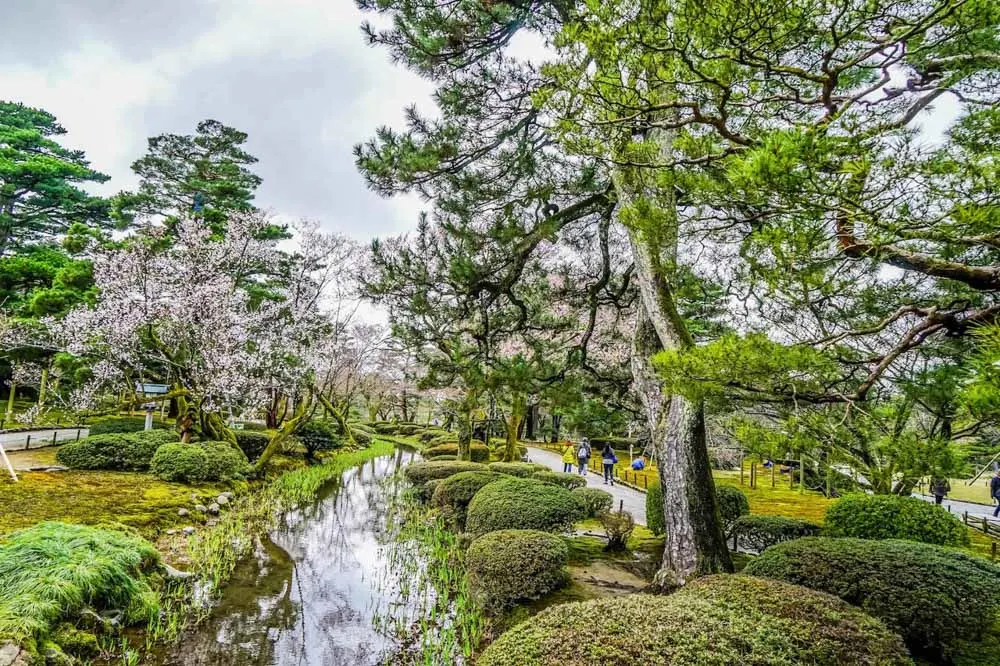
Kanazawa Gardens – photo by Inspired By Maps
Go for a ride at Fuji Q Theme Park
“One of our top Japan bucket list experiences was to visit the Fuji Q theme park, located near Kawaguchiko, or the Five Lakes area.
Fuji Q has some of the top rollercoasters in the world, so if you love thrill rides then you should definitely plan to visit Fuji Q.
There’s the added bonus that Mt Fuji sits as a backdrop to the whole theme park, when the weather is good you should get views on most rides.
If you love thrill rides then you will definitely want to check out and ride on the ‘Big Four’ rollercoasters – Eenajaika (upside down anyone?), Takabisha (steepest), Dodonpa (fastest) and Fujiyama (fun!).
You can easily get to Fuji Q from Tokyo on the Express Bus from Shinjuku Station, also by train from Kawaguchi Station.
You can purchase a Fuji Q entry ticket either on site or online, and there are also some skip the queue ticket options.”
– by Anne Sutherland-Smith, author of Pretraveller
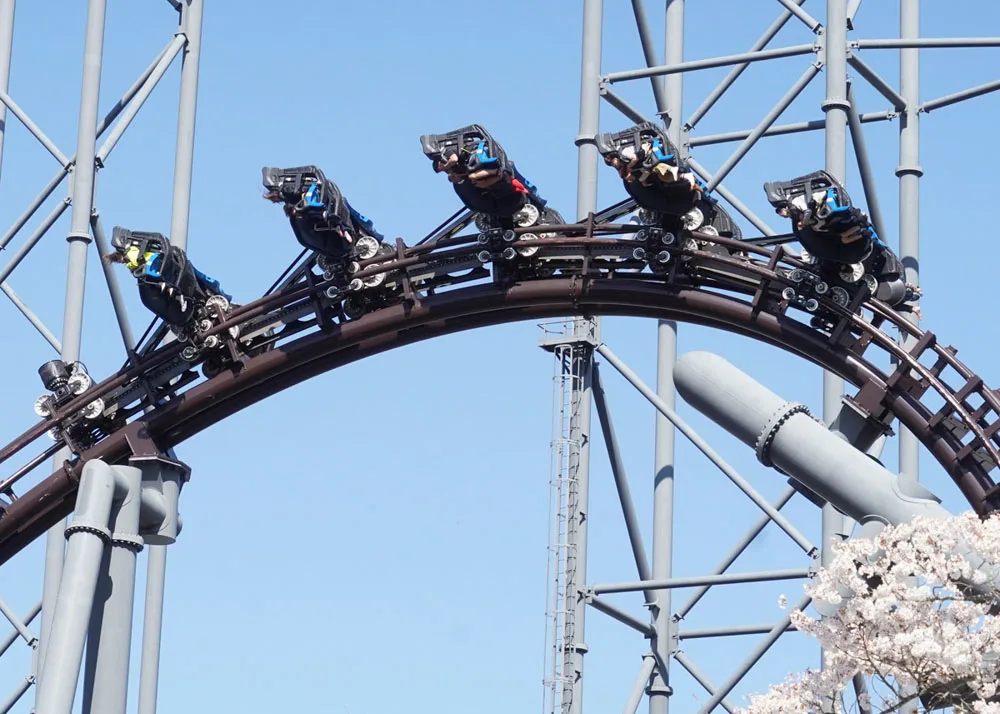
Fuji Q Theme Park – photo by Pretraveller
Japan Bucket List – Kyushu & Okinawa Region
Chill at the beaches of Okinawa
“Across the globe, Okinawa is probably best known for the following claim: its people have the longest life expectancy in the world.
The claim, it’s said, comes from the Okinawa diet of pickled seaweed and purple potato ice cream. An acquired taste but one worth trying once.
For the traveller, though, Okinawa brings turquoise shores with soft sand and a tropical, more relaxed vibe to their Japan itinerary.
Most people fly here direct from Tokyo and then spend a few days on the beach and in the city. Seek out places that explore the local Ryuku culture and make sure to make it to Taketomi Island where the sand is the shape of small stars.”
– by Abigail King, author of Inside the Travel Lab
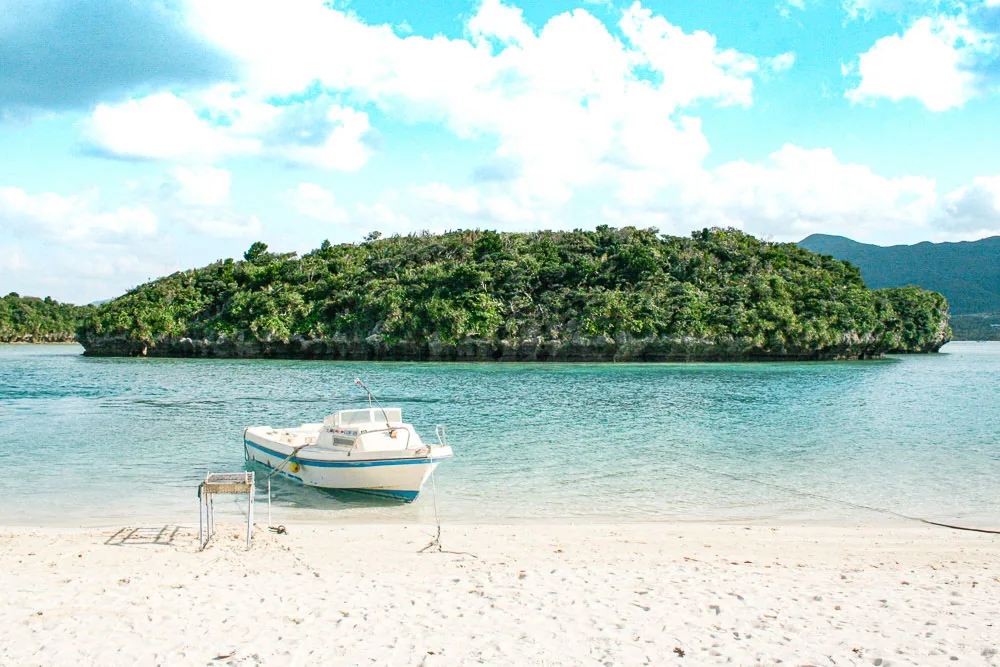
The tropical beaches of Okinawa – photo by Inside the Travel Lab
Explore Takachiho Gorge in Kyushu
“Takachiho Gorge is one of the most incredible spots on the island of Kyushu in Japan.
In the forest of Miyazaki a natural gorge has formed around the Gokase River where you can find the 17-meter high Minainotaki Waterfall, which pours into the river below.
Giant Basalt columns line the sides of the Gokase River, which make this gorge even more unique.
In the fall you get the beautiful tinged orange and different colors on the trees, and in the summer you are blessed with the beautiful weather and incredible light rays shooting through the gorge at the right time of the day.
The first way to enjoy Takachiho gorge and the Minaionotaki Waterfall is to paddle underneath the stone bridge in a row boat, which can be hired for $50 per hour and then alongside the Minainotaki Waterfall.

Takachiho Gorge in Kyushu – photo by Journey Era
The waterfall will spray you as you paddle by and enjoy the stunning gorge, which is made of volcanic basalt columns.
The columns are said to resemble the scales of a dragon where the stones were twisted when the river flowed in the formation of the gorge.
The second way to enjoy the Takachiho Gorge is from one of the many viewing points.
The lower (most popular) viewpoint gives you a very elevated view of the boats and the waterfall below, framed nicely by the overhanging trees and the walls of the gorge.”
– by Jackson Groves, author of Journey Era
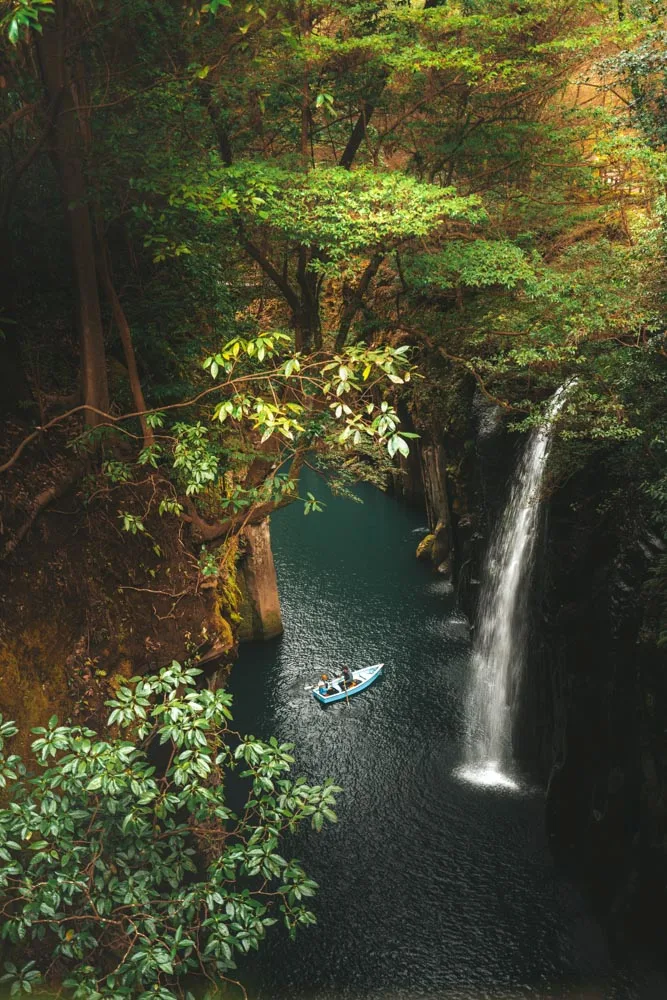
Takachiho Gorge in Kyushu – photo by Journey Era
Hike to the crater of Aso Volcano
“Mount Aso Volcano, an active volcano in the Kyushu region of Japan, is a great bucket list addition. The volcano is also one the largest on Earth, with a caldera stretching over 100 kilometres.
The whole region, with its green rolling hills stretching outwards, is stunning, but of course, Aso is the focal point. The plumes of smoke billowing from the volcano are a spectacular sight.
At certain times, when the atmosphere is not too toxic, you can also walk around the aqua blue crater lake of the central Nakadake volcano. This is a unique opportunity to stare right into the heart of a volcano.”
– by Cass, author of Cassie The Hag
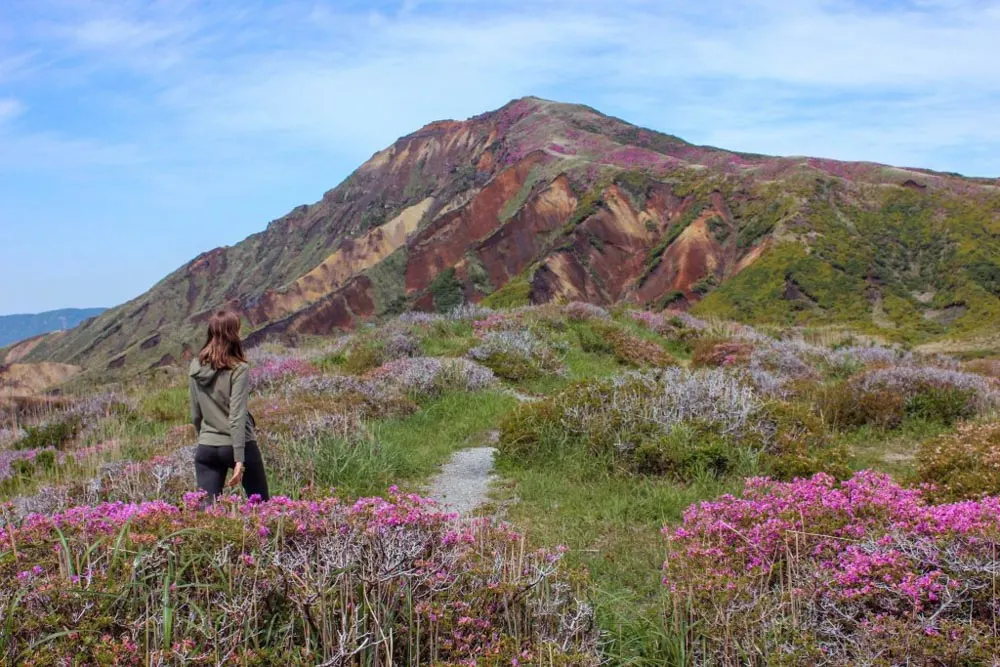
Exploring Mount Aso Volcano in Kyushu – photo by Cassie The Hag
Japan Bucket List – Hokkaido Region
Visit the flower fields of Furano and Biei, Hokkaido
“While Hokkaido is better known as a winter destination, seeing the flower fields here is considered by many local Japanese as one of the best things to do in Hokkaido during the summer.
The towns of Furano and Biei are known not only for their flower fields but more specifically for their lavender fields. These are best seen from mid-July to early August.
If you’re just excited to see flowers, visiting any time between June and August will guarantee beautiful flower fields.
The two best fields to visit are the Farm Tomita (more popular and busier) and Shikisai no Oka (which is less busy but still beautiful). Both fields are free to visit and they also sell lavender goods (including lavender flavored soft-serve!)
For travelers visiting Japan during the summer, Hokkaido’s flower fields are a definite must and worthy of your Japan bucket list.”
– by MG, author of The Wandering Suitcase

Shikisai no Oka flower Fields in Hokkaido – photo by The Wandering Suitcase

Shikisai no Oka flower Fields in Hokkaido – photo by The Wandering Suitcase
Ski in Niseko
“Niseko is Japan’s powder capital, and it’s unlike any other ski resort in the world.
Combining outstanding cuisine, five-star accommodation, top-quality cocktails, epic backcountry, and open-air onsens, it’s the winter wonderland that you’ve been dreaming of.
Add in the spectacular views of Mount Yōtei (read Mount Fuji of the north), and you’ll never want to leave.
Across the valley, four resorts cling onto the face of Mount Annupuri (1,309m), and the sensational night ski means you won’t find yourself bored.
An All Mountain Pass will cover access to the entire mountain and a handy (and free) shuttle service is thrown in too. Fly to nearby Sapporo or Hakodate (also served by the Shinkansen) and get ready for an adventure – Japanese style.”
– by Emma, author of WITRAG travel

Skiing in Niseko with views of Mount Yōtei – photo by WITRAG Travel
Visit the Sapporo Snow Festival
“There are many reasons to visit Hokkaido, the northern-most island of Japan during a visit. But if you happen to be in Japan in February you simply cannot miss the famous Sapporo Snow Festival.
It is held in the main city of Hokkaido for 7 days and draws huge crowds, not only foreign tourists but also domestic travelers enjoy the spectacular sculptures made from snow and ice and the delicious local food like Japanese crabs, Miso Ramen, soup curry, and Jingisukan.
While you are there make sure to check out other parts of Hokkaido as well such as Otaru and Niseko.
Because of the popularity of the event, it is advisable to book your hotel way in advance, and expect prices to be high. The easiest way to get to Sapporo from Tokyo is by air flying to New-Chitose Airport.”
– by Lena Yamaguchi, author of Nagoya Foodie

Sapporo Snow Festival – photo by Nagoya Foodie
Final thoughts on the 33 best things to do in Japan
So there you have it, the ultimate Japan bucket list! This bucket list is a combination of my own experiences and those of other travel bloggers.
I tried to include only the most famous and iconic Japanese experiences. I hope you find it useful in planning your own Japan bucket list and trip!
Have you been to Japan before? How did you find it? Let me know in the comments below! If there are other epic Japanese experiences that should feature in this bucket list let me know, I’d be happy to add them!
Enjoyed reading about the most beautiful places in Japan? Pin it!

